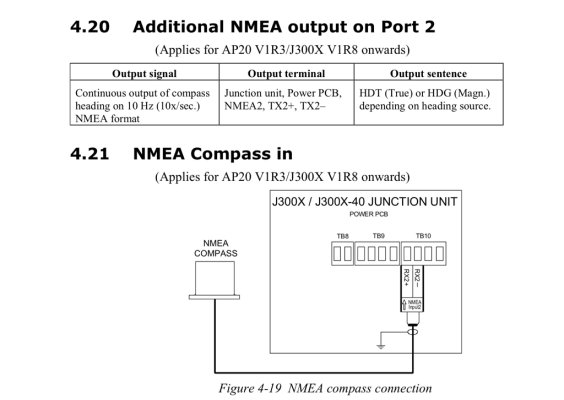O C Diver
Guru
- Joined
- Dec 16, 2010
- Messages
- 12,865
- Location
- USA
- Vessel Name
- Slow Hand
- Vessel Make
- Cherubini Independence 45
I'm considering adding a satellite compass to make the autopilot track better and had a few questions. I have a very recent Garmin plotter system with a nmea 2000 network. The autopilot is an older Simrad AP20 with a standard fluxgate compass. Simrad is of no help and basically offers no support for their older equipment. The autopilot functions properly and I have a remote docking station and a remote steering control that I'm very happy with, so I really don't want to change autopilots if I can help it.
Questions:
If I add a satellite compass through my nmea 2000 network, does the faster more precise heading sensor make my plotter more precise which then makes the autopilot more precise, or is the autopilot rate of response controlled by it's fluxgate compass?
The Simrad AP20 is nmea 0183. If the satellite compass is nmea 2000 and running through my plotter to the autopilot, will that work or does it require a converter of some type?
If a satellite compass will significantly improve my autopilots tracking performance, which one do you like? Have been reading information on the different makes and models and am suffering from information overload. Was hoping for a relatively simple plug and play with my nmea 2000 network. Was hoping not to have to add another display to the console. As I am a simple man, I need some simple answers.....this stuff has my head spinning.
Ted
Questions:
If I add a satellite compass through my nmea 2000 network, does the faster more precise heading sensor make my plotter more precise which then makes the autopilot more precise, or is the autopilot rate of response controlled by it's fluxgate compass?
The Simrad AP20 is nmea 0183. If the satellite compass is nmea 2000 and running through my plotter to the autopilot, will that work or does it require a converter of some type?
If a satellite compass will significantly improve my autopilots tracking performance, which one do you like? Have been reading information on the different makes and models and am suffering from information overload. Was hoping for a relatively simple plug and play with my nmea 2000 network. Was hoping not to have to add another display to the console. As I am a simple man, I need some simple answers.....this stuff has my head spinning.
Ted





 Somebody please explain to me why people have such a hard time removing obsolete wiring from a boat.
Somebody please explain to me why people have such a hard time removing obsolete wiring from a boat.